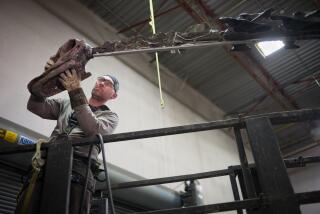Lucy fossil debuts amid controversy
HOUSTON -- After six years of planning and negotiations, and a controversy reverberating through the scientific community, the world’s most famous fossil made her debut Tuesday.
Lucy, a 3.2 million-year-old Australopithecus afarensis, was unveiled during a media preview at the Houston Museum of Natural Science, where she will be the centerpiece of an exhibit opening Friday.
“Lucy’s Legacy: The Hidden Treasures of Ethiopia” features more than 150 religious and cultural artifacts from Ethiopia -- a part of the exhibit that museum officials and the Ethiopian government worry may be overshadowed by the furor surrounding Lucy.
The decision to bring Lucy to Houston for public display spurred outrage among the world’s most noted paleoanthropologists -- including famed fossil hunter Richard Leakey -- who say the fragile fossil could be irreparably damaged by the travel to Houston and a subsequent six-year tour.
Noted museums such as the Smithsonian Institution in Washington, D.C., and the American Museum of Natural History in New York refused offers to exhibit Lucy. The Cleveland Museum of Natural History, where Lucy was studied for six years after her discovery in 1974, also refused to show her.
The Houston exhibit marks the first time Lucy has been on view in public outside Ethiopia, where she has only been exhibited twice. Ethiopian government officials hope the exhibit will spark tourism and dispel the image of the country as a war-torn, famine-plagued land.
More to Read
Sign up for Essential California
The most important California stories and recommendations in your inbox every morning.
You may occasionally receive promotional content from the Los Angeles Times.










